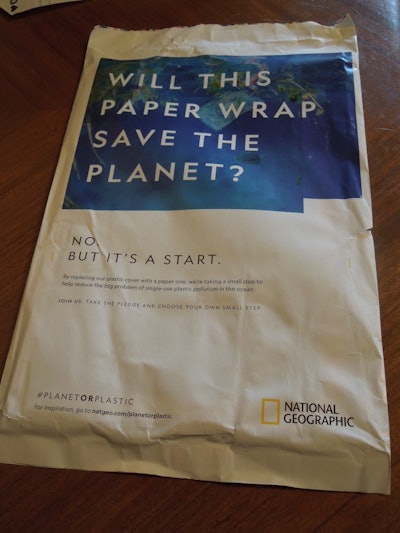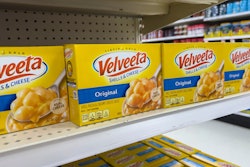Instead of the usual plastic wrapper, the June issue of National Geographic arrived by snail mail in a paper package with this headline: “WILL THIS PAPER WRAP SAVE THE PLANET?”
Just beneath the headline came their response: “NO. BUT IT’S A START. By replacing our plastic cover with a paper one, we’re taking a small step to help reduce the big problem of single-use plastic pollution in the ocean.”
The iconic magazine’s gut-punch to plastics is supported by its natgeo.com/planetorplastic website, which encourages consumers to choose the planet. To wit, the headline for the site’s lead article reads, “We Depend On Plastic. Now, We’re Drowning in It.” Its “From The Editor” column headline, “The Plastic Apocalypse,” sounds yet more ominous.
National Geographic is hardly alone in its condemnation of plastic. Nearly two years ago, a World Economic Forum headline reported, “Every minute, one garbage truck of plastic is dumped into our oceans. This has to stop.” It has not.
In fact, plastic marine litter has become such a hot-button issue that in its 4th Progress Report, the Global Plastics Alliance collaboration pointed to some 355 projects addressing marine litter that had been planned, were underway, or were completed as of December 2017.
More alarming details are reported in The New Plastics Economy: Rethinking the Future of Plastics, a report written by Project MainStream, launched in 2014 by the World Economic Forum and the Ellen MacArthur Foundation, with McKinsey & Company as knowledge partner. Among the more notable points are the following:
• Today, 95% of plastic packaging material value, or $80 billion to $120 billion annually, is lost to the economy after a short first use.
• An overwhelming 72% of plastic packaging is not recovered at all: 40% is landfilled, and 32% leaks out of the collection system—that is, either it is not collected at all, or it is collected but then illegally dumped or mismanaged.
• Without significant action, there may be more plastic than fish in the ocean, by weight, by 2050. Even by 2025, the ratio of plastic to fish in the ocean is expected to be one to three, with plastic in the ocean forecast to grow to 250 million tons.
Dell’s five-step plan
Dell Technologies is taking a stand on green packaging and shipping, noting that 8 million tons of plastic enter the ocean every year. It noted this ominous factoid from the BCC on its website: “Anyone who consumes an ‘average amount’ of seafood ingests c. 11,000 plastics particles per year.”
“Dell wants to help break this cycle by keeping plastics in the economy and out of the ocean,” it says. “To those ends, we are creating the first commercial-scale global ocean-bound plastics supply chain. We are processing plastics collected from beaches, waterways, and coastal areas and using them as part of a new packaging system for the XPS 13 2-in-1 laptop globally. This initial pilot project will start by keeping 16,000 pounds of plastic out of the ocean.”
The five-step Dell plan involves plastics collection, sortation by waste processors, refining and mixing with recycled high-density polyethylene containers, molding into packaging trays for Dell XPS notebook computers, and then making the trays curbside-recyclable to serve as “a viable resource in the circular economy.”
Plastics recycling could bring some relief, but “solving the issue is about as large and complex as the ocean itself,” declares “The Mechanics of Effective Recycling,” an article from HSM UK. It lists several programs underway that aim to address plastics litter in oceans, including “The Farm Project” initiative, which aligns with Dell’s factoid: “If plastic is making its way into the stomachs of sea life, then who’s to say it’s not ending up in ours, too?”
UK Plastics Pact
The UK Plastics Pact initiative was developed to create a circular economy for plastics, setting the following ambitious 2025 targets:
• That 100% of plastic packaging be reusable, recyclable, or compostable
• That 70% of plastic packaging be effectively recycled or composted
• Take actions to eliminate single-use packaging items through redesign, innovation, or alternative (reuse) delivery models
• That all plastic packaging include on average 30% recycled content
Among UK Plastics Pact members and partners are Aldi, Coca-Cola European Partners, Danone, P&G, Tesco, Greiner Packaging, and SABIC.
An April 30 article in The Ecologist believes the voluntary pact doesn’t go far enough, noting, “The Green Party is calling for a ban on all unnecessary single-use plastic.”
Plastic recycling lags behind
In a new Euromonitor report, Ethical Living: Plastic—Lose It or Re-Use It? Rosemarie Downey, Euromonitor’s Head of Packaging Research, sheds light on the issues limiting plastics packaging recycling: “Plastic has such a ubiquitous presence in modern-day society that it is difficult to imagine the impact of being without plastic. Globally, plastic recycling is increasing but tends to lag behind other materials. In part, the ability to produce virgin plastic so economically has thwarted the development of recycled plastics. However, with a growing sense of environmental stewardship, creating capacity of recycled plastics and brands’ uses of them looks set to rise. Currently, around 30% of plastics in Europe, 25% in China, and 9% in the U.S. are recycled.
“Attention is on those single-use plastics with a very short lifespan littering the environment. Solutions to address waste or alternatives are sought. Plastic, however, holds a highly valuable, functional role in protecting and preventing food waste. With its success in use, however, comes responsibility post-use to reduce its occurrence as environmental waste. Mindful consumption of plastic is a global duty; consumers have their part to play to help realize zero litter (the dream), as do corporate players in their use and handling and governments in providing the necessary infrastructure.”
Packaging supplier Pregis announced May 3, 2018, that it was joining the How2Recycle coalition to help simplify recycling instructions for consumers. “For many packaging material types, there is consumer confusion regarding recyclability and disposal. The How2Recycle approach uses labels printed directly onto the packaging material, which gives the consumer specific recycling instructions,” says Pregis Chief Innovation Officer Tom Wetsch. “The goal is to reduce consumer confusion and increase the amount of material that can be reclaimed and used in new lifecycle applications.”
Greater plastics packaging demand
Modest plastic packaging recycling numbers and the apparent economic benefits of producing plastics from virgin materials make the litter issue even more of a challenge, both on land and at sea. Yet there’s a third complicating factor, which relates to demand for greater future use of rigid plastic food containers.
In its new Food Containers in the U.S. 11th Edition study, market research firm Freedonia predicts demand for rigid plastic food containers will increase 4.2% annually to $7.7 billion by 2022. Light weight, low-cost, and crush/shatter-resistance characteristics lend appeal for these containers.
The popularity of smaller, single-serve containers for convenience and portion control is further increasing rigid food container demand. So even if containers are produced using less raw material to meet barrier requirements and save material and shipping cost by decreasing fuel consumption, the result is still more plastic.
Cosmetics packaging gains
The call for consumers to play a more significant role in reducing plastics packaging waste was mentioned in the April 25 Fashionista article, “Beauty Brands Are Finding Innovative Ways to Reduce Packaging Waste,” which was posted at Yahoo.com/Lifestyle.
The article cites examples of sustainable packaging developments with positive environmental impact. However, the story also quotes Ashlee Piper, a sustainability expert, TV personality, and author, as saying, "It's critical for consumers to stay vigilant and not be greenwashed by lessened packaging alone."
The story notes, “Packaging does play a significant role in a company's carbon footprint, or lack thereof. Most beauty products are swathed in plastic, but only 12% of plastic is recycled, which means that eight million tons end up in our oceans every year. By 2050, there will be more plastic in the ocean than fish, and, already, nearly 80 million tons of plastic comprise the Great Pacific Garbage Patch.”
Help and hope
This patch, located between Hawaii and California, reportedly represents the largest trash accumulation area in the ocean, made up of 1.8 trillion pieces of plastic weighing 80,000 metric tons, according to The Ocean Cleanup. The Delft, Netherlands-based organization is made up of more than 70 engineers, researchers, scientists, and computational modelers “working daily to rid the world’s oceans of plastics.”
Rather than using conventional methods—such as nets and vessels—to clean up the patch, which The Ocean Cleanup says, “would take thousands of years and tens of billions of dollars to complete,” its passive systems technology aims to “remove half of the patch in five years, and at a fraction of the cost.” Set to deploy this year, the floating system will use a screen and—get this—HDPE pipe to catch and concentrate plastic while providing buoyancy.
ScienceDirect in late 2017 published a detailed report, Solutions for global marine litter pollution, which illustrates the issue’s daunting complexity. It noted, “Successful actions aim at a diversity of goals, ranging from changing consumer behavior, the introduction of new technologies, the design, implementation, and enforcement of a multitude of plans, policies, and laws, to full-scale revision of current practices of production, use, and management of waste. This implies active involvement of consumers, producers, policy makers, managers, inhabitants, tourists, (fisheries) industries, companies, and many other actors. A move toward sustainable and resilient societies may need to raise awareness and involvement of all stakeholders in society.”
Ellen MacArthur Foundation
Established in 2010 to speed the transition to a circular economy, The Ellen MacArthur Foundation’s aforementioned 61-page report provides detailed findings and conclusions that thoughtfully dissect and articulate plastic waste issues that dive deeper than matters pertaining to the oceans. It describes a “New Plastics Economy” that proposes new thinking by developing an “after-use plastics economy.”
The report assesses the plastic packaging value chain, describes hard-to-recycle materials such as polyvinyl chloride, expanded polystyrene, and labels. The report’s executive summary points to economics as key in addressing environmental concerns related to plastics packaging:
“The cost of such after-use externalities for plastic packaging, plus the cost associated with greenhouse gas emissions from its production, is conservatively estimated at $40 billion annually—exceeding the plastic packaging industry’s profit pool. In [the] future, these costs will have to be covered. In overcoming these drawbacks, an opportunity beckons: enhancing system effectiveness to achieve better economic and environmental outcomes while continuing to harness
the many benefits of plastic packaging. The ‘New Plastics Economy’ offers a new vision, aligned with the principles of the circular economy, to capture these opportunities.”
Editor’s note: This is an expanded version of a story first posted to this website May 3, 2018.























